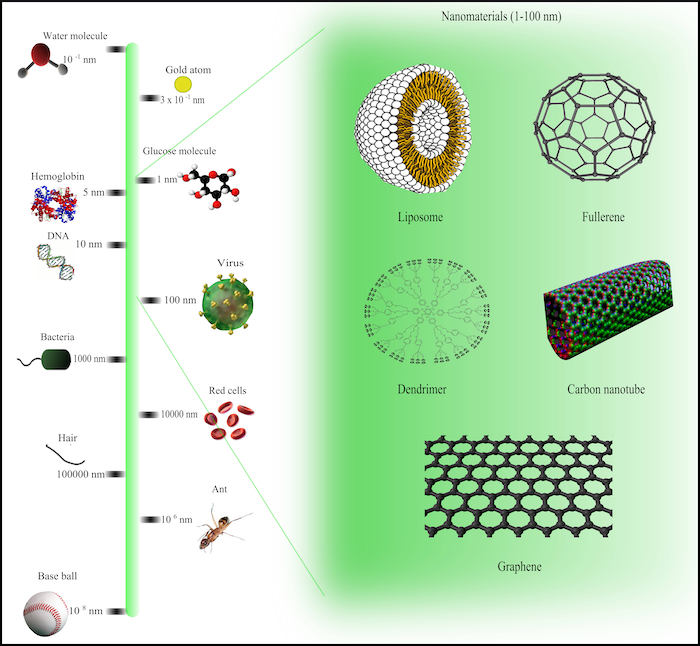Nanotechnology involves manipulating atoms and molecules to give structures new chemical and physical properties. Nanotechnology devices have a wide range of applications, such as electronics, medicine, energy, textiles and more. These devices typically have a scale of fewer than 100 nanometers (nm). A nanometer is a very small unit of measurement equal to one billionth of a meter. For reference, a sheet of paper is about 100,000 nanometers thick.
What Is Nanotechnology?
Nanotechnology refers to any device or product that is created or modified by manipulating matter at the nanoscale. By controlling atoms and molecules, companies can develop nanomaterials no more than 100 nanometers thick and apply these materials to industries like healthcare, sports and electronics.

What Is Nanotechnology?
Nanotechnology refers to the practice of manipulating atoms and molecules at the nanoscale, which is between one and 100 nanometers. By making alterations at the atomic level, researchers can transform the chemical and physical properties of a substance. This can lead to new macrotechnologies with enhanced properties, including greater endurance and increased conductivity.
Why Is Nanotechnology Important?
We can use nanotechnology to create materials, devices and systems with unique properties and functions. The very small size of the materials allows them to exhibit different physical and chemical properties than the same materials at a larger scale. Due to their small size, nanomaterials have a large surface area-to-volume ratio, which can lead to increased reactivity, strength and conductivity.
Additionally, the small size of nanomaterials allows them to be easily incorporated into a wide variety of products and processes, including electronic devices, medical treatments, energy production and environmental remediation. The properties of nanomaterials also make them useful for creating new products and improving existing ones, such as increasing the efficiency of solar cells and batteries, creating stronger and more durable materials for construction and developing more effective medical treatments.
Examples of Nanotechnology
There are many examples of nanotechnology used in everyday life. Some of the most common applications include:
- Electronics. We use nanomaterials in smartphones, laptops and televisions. Nanomaterials help to improve various properties of these devices such as conductivity, strength and durability.
- Cosmetics. Some cosmetics, like foundations and moisturizers, contain nanoparticles that can help to improve the product’s texture and appearance.
- Sporting goods. Some sports equipment, such as golf clubs and tennis rackets, contain nanomaterials that can help to improve their performance. For example, nanoclay is added to soccer and tennis balls to increase their life spans.
- Clothing. Some clothing, such as outdoor gear and athletic wear, contain nanomaterials that can make them more durable and water-resistant, or even reduce odor.
- Sunscreen. Zinc oxide and titanium oxide can be added to sunscreens at the nanoscale, making sunscreens stronger and longer-lasting with limited health risks.
- Furniture. Manufacturers create more lightweight yet durable furniture with nanomaterials. Nanomaterials can also increase the endurance of furniture’s colors.
- Adhesives. Nanoparticles can strengthen adhesives without sacrificing stickiness, raising the durability of adhesive materials.
- Automotive. Automotive manufacturers are experimenting with nanomaterials to make car coats more wear-resistant and enable cars to heal scratches on their own.
Nanomaterials vs. Nanoparticles
Nanomaterials are materials that have at least one dimension that can be measured at the nanoscale. These materials can be manufactured or found in nature. Common examples of nanomaterials include:
- Fullerenes: Ultra-thin sheets of graphene — a form of carbon — that are rolled up into spheres or tubes
- Nanotubes: A form of carbon that takes on a tube shape and possesses a diameter that can be measured at the nanoscale.
- Nanocrystals: A solid material with a highly organized atomic structure that is measurable at the nanoscale.
- Dendrimers: Symmetrical molecules that contain branches of repeating groups of atoms and can be measured at the nanoscale.
On the other hand, nanoparticles are isolated solid-state objects that must be measurable at the nanoscale on all three dimensions. These particles are used to create nanomaterials and are considered a category of nanomaterials. Examples of nanoparticles include:
- Gold nanoparticles: Clusters of gold atoms measurable at the nanoscale.
- Silver nanoparticles: Clusters of silver atoms measurable at the nanoscale.
- Quantum dots: Nanocrystals known for having high conductivity.
- Polymer nanoparticles: Particles measurable at the nanoscale that contain large macromolecules, which include repeating chains of atoms.
Types of Nanomaterials
The broader category of nanotechnology can be broken down into four main types:
- Carbon-based nanomaterials. Include carbon nanotubes created through carbon-based vapor deposition, where heated carbon is added after a reaction between a surface and a catalyst.
- Metal-based nanomaterials. Include quantum dots, which are developed by growing nanoscale crystals of two different elements in a solution under specific conditions.
- Dendrimers. Exist as nanoparticles that consist of a core, inner shell and outer shell and can be constructed starting from the core or outer shell.
- Nanocomposites. Composed of either multiple nanomaterials or a mix of nanomaterials and larger materials, forming stronger metals, plastics and other substances.
How Is Nanotechnology Made?
There are several methods for creating nanomaterials, including:
- Top-down approaches. Starting with a larger piece of material, we can use tools like lithography to carve or etch the material down to the nanoscale. Scientists do this using various techniques such as laser ablation, chemical etching or mechanical milling. This approach is used during the fabrication of integrated circuits in electronics.
- Bottom-up approaches. These techniques involve building up materials from smaller components, such as atoms or molecules. This can be done using techniques such as chemical synthesis or self-assembly. One example of an application of nanotechnology where a bottom-up approach is used is the synthesis of nanoparticles.
- Self-assembly. This technique involves designing materials or structures in such a way that they spontaneously organize themselves into the desired nanoscale structure. We can do this using techniques such as template-assisted self-assembly or directed self-assembly. We can see self-assembly at work in the production of block copolymers.
- Physical vapor deposition. This involves vaporizing a material and then depositing it on the surface of the material to form a thin film, such as in the coating of cutting tools.
- Chemical vapor deposition. This involves reacting a gas with a surface to create a thin film of the desired material, which we see in the production of thin films for solar cells.
What Are the Benefits of Nanotechnology?
There are many potential benefits to nanotechnology, including:
- Improved materials. Nanomaterials can be stronger, lighter and more durable than traditional materials. These improvements can lead to a wide range of applications in a number of industries including construction, transportation and consumer products.
- Increased energy efficiency. We can use nanomaterials to create more efficient batteries and solar cells. These materials can help reduce our reliance on fossil fuels and reduce greenhouse gas emissions.
- Enhanced medical treatments. We can use nanotechnology to create more targeted and effective drugs, as well as diagnostic tools and medical devices.
- Improved water filtration and purification. We can use nanomaterials to create more effective filters for removing contaminants from water.
- Improved food safety and agriculture. With the help of nanotechnology, we can create sensors for detecting food contaminants, as well as fertilizers and pesticides that are more targeted and less harmful to the environment.
What Are the Risks of Nanotechnology?
There are also potential risks associated with nanotechnology, including:
- Health and environmental risks. We don’t yet fully understand the long-term health effects of exposure to nanomaterials. There are concerns that nanotechnology in food, for instance, could be harmful to humans and the environment. The use of nanotechnology in pesticides adds another threat to humans and the environment.
- Economic risks. There is potential for nanotechnology to disrupt traditional industries and create economic inequality. A functioning nanocomputer would be hundreds of times more computationally powerful than the most powerful conventional computers. It could give those who have access to the technology a significant advantage in areas such as stock trading, financial modeling and other data-intensive industries. A nanocomputer could also lead to job displacement as certain tasks and industries become automated by the powerful technology.
- Ethical risks. There are also ethical concerns surrounding the use of nanotechnology, such as the potential for it to be used for military or surveillance purposes. In the healthcare industry, the introduction of nanotechnology could lead to harmful side effects and raises questions around data privacy as well.
- Existential risks. The gray goo scenario depicts a nightmare reality where self-replicating nanotechnology is able to reproduce rapidly, eventually consuming the rest of the planet. While this situation is largely considered to be science fiction, the development of self-replicating nanobots may reignite fears of a nanotechnology takeover.
Frequently Asked Questions
What is nanotechnology?
Nanotechnology is any product that is designed or manipulated by altering atoms and molecules at the nanoscale. These products often contain nanomaterials, which are no thicker than 100 nanometers and make it easier to modify a product’s physical properties.
What is an example of nanotechnology?
An example of nanotechnology is making athletic and outdoor clothing more durable and water-resistant by equipping them with nanomaterials.
How is nanotechnology used in real life?
Nanotechnology is used to increase the conductivity of electronic devices, produce lightweight yet longer-lasting furniture and make car coats wear-resistant and self-healing, among other real-life applications.
Nanomaterials vs. nanoparticles
Nanoparticles are isolated objects that are measured on the scale of nanometers, or billionths of a meter. All three dimensions of a nanoparticle need to be measurable on the nanoscale. Meanwhile, nanomaterials are materials made up of nanoparticles, and only one of their dimensions needs to be measurable on the nanoscale. As a result, nanoparticles are a category of nanomaterials.





